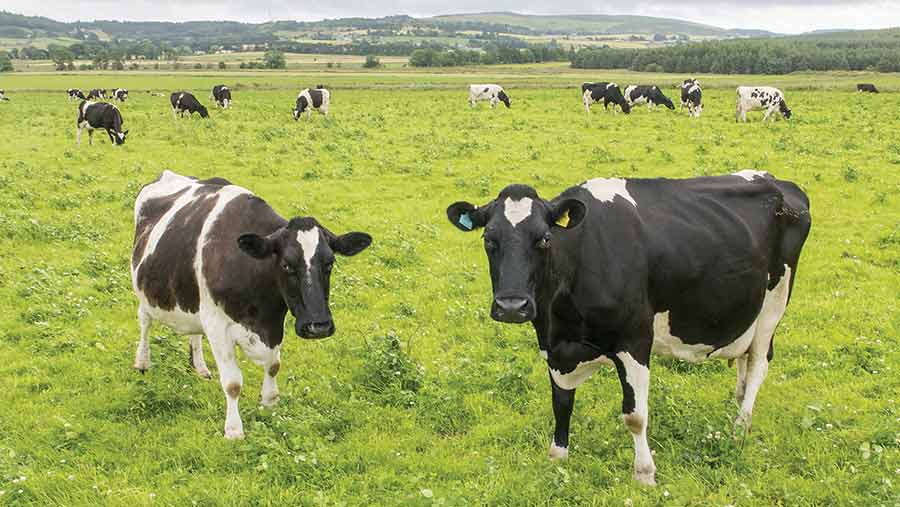How to budget for dairy feed supplements
 © Angus Findlay
© Angus Findlay With lower milk prices and a stagnant world economy, the usual challenges are being directed at farmers and advisers alike.
In these conditions, which are likely to last for at least another 12 months or so, how can one improve profitability?
The recent historic high price of supplements has exacerbated this issue, although these feed costs will have fallen significantly by the end of this spring.
For all farmers, it is essential and non-negotiable to maintain a low-cost structure for most standard areas, such as animal health, breeding, repairs and maintenance, vehicle expenses and administration fees.
But what about the big variable costs? What price can you afford to pay for supplements to produce milk? What is a sustainable level of expenses as a proportion of income?
Many will be tired of hearing the same questions being asked year after year, just as some of you may be frustrated by not getting a simple, clear answer.
Sadly, the answer is different for each farmer and can only be answered with some proper financial analysis.
See also: How to review dairy welfare costs
Sustainable levels of expense as a percentage of revenue or cost per kg of milk solids or litre of milk depends upon the farming system being run.

Tony Evans, head of business consultancy, The Andersons Centre
A lower supplemented farming system would typically need to run a lower level of cost as a proportion of income to generate the same profit as a highly supplemented milking system.
In almost every business, one increases expenses when one adds supplement to pasture-based farming as grazed grass is usually the lowest cost fees; although the intent is to increase profit it also increases risk.
The key to answering all these questions is to know how one is performing at present, what level of true progress has been made, what has driven that progress and how you compare to your peers, as this may provide a guide in areas for future improvement.
Milk price:supplement ratios provide a good example of how and when to consider using supplements:
| 2014 | 2015 | 2016 | |
| Milk price (p/litre) | 32 | 26 | 22.5 |
| Supplement price (£/t) | 213 | 190 | 175 |
| Supplement price (p/kg) | 21.3 | 19 | 17.5 |
| Milk price:Supplement ratio | 1.50 | 1.37 | 1.29 |
The greatest single operating expense on dairy farms is often purchased feed. So those that are heavily reliant on bought-in supplements are exposed to a wider range of vagaries, including world feed demand, exchange rates and higher-cost systems of feeding.
These systems in 2014 were likely to be more profitable than in 2016 and will need exceptional management and exceptional cows.
The most resilient dairy businesses are those that know when to feed higher-priced feeds.
| £/t dry matter | cost/MJ | cost/litre | |
| Grazed grass | 59 | 0.51 | 3p |
| Grass silage | 96 | 0.87 | 5p |
| 14% concentrate | 182 | 1.42 | 8p |
Dr John Roche, a renowned dairy cow nutrition expert who also focuses on dairy profitability, has consistently demonstrated in all major dairy producing countries that profitability increases as the proportion of grazed grass in a cow diet increases.
A 7,000-litre cow cost of feed comparison:
| Option 1 | 2,000kg concentrates (ie. 3,000 litres from forage) |
| 50:50 diet of grazed grass and silage in a year | |
|
Annual feed cost: £692/cow, 9.9p/litre |
|
| Option 2 | 1,500kg concentrates (ie. 4,000 litres from forage) |
| 50:50 diet of grazed grass and silage in a year | |
| Annual feed cost: £639/cow, 9.1p/litre | |
| Option 3 | 1,500kg concentrates (ie. 4,000 litres from forage) |
| 69:31 diet of grazed grass and silage in a year | |
| Annual feed cost: £569/cow, 8.1p/litre |
The difference between Option 1 and Option 3 reduces cost of production by 1.8p/litre. Plus less power and labour costs are required to feed and clear up after the cow.
This year has also seen the introduction of production limits on dairy farms by many milk buyers to reduce the milk surpluses.
Such surpluses may only receive up to 16p/litre, so with a milk price concentrate ratio of 1.14p and falling feed efficiency as cow yields increase (ie. producing the marginal litre), the likelihood of more profit from more milk is very marginal and with spare cash becoming limited, can you take the risk?
